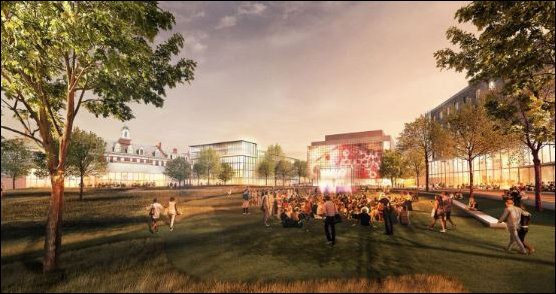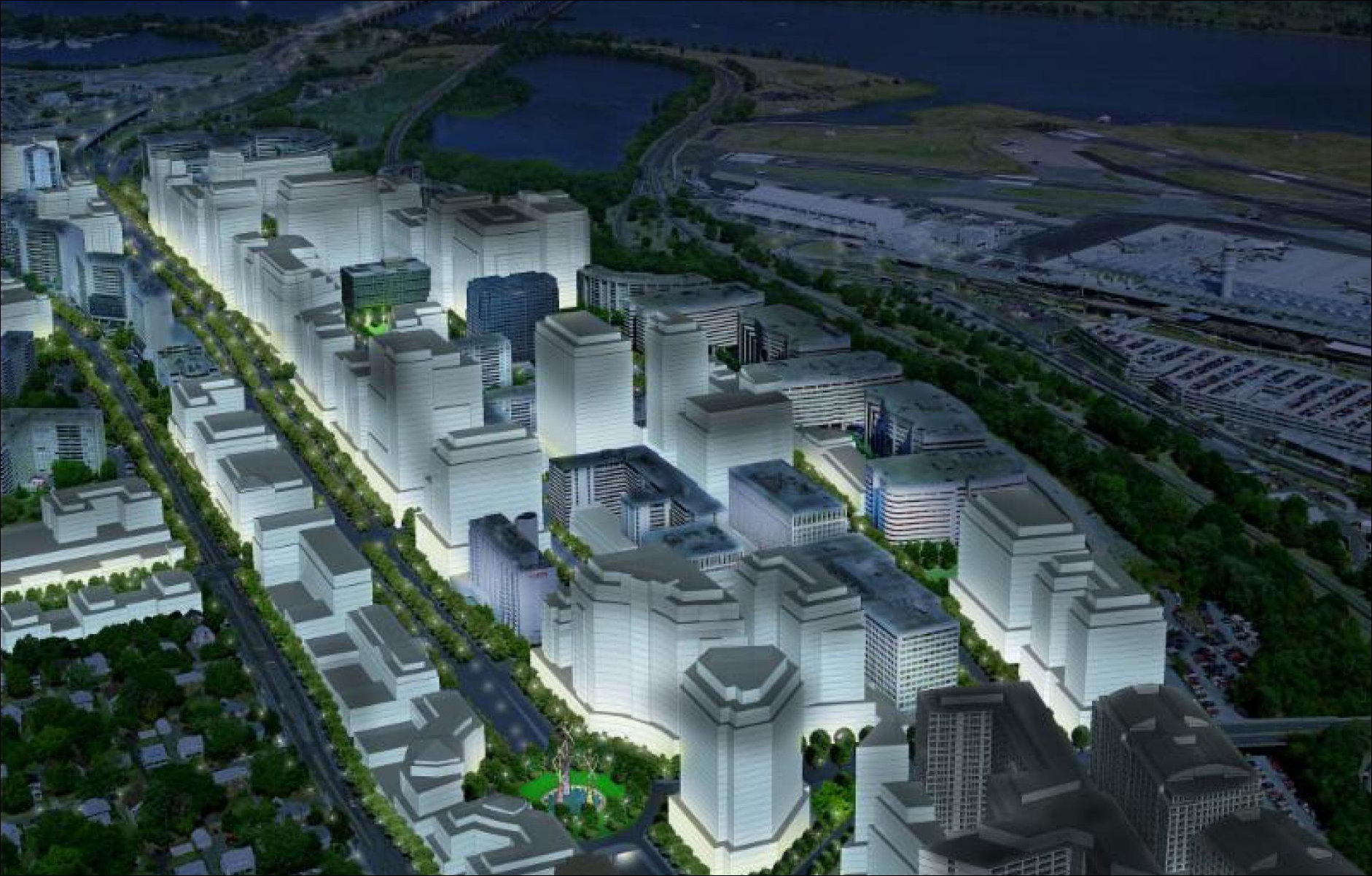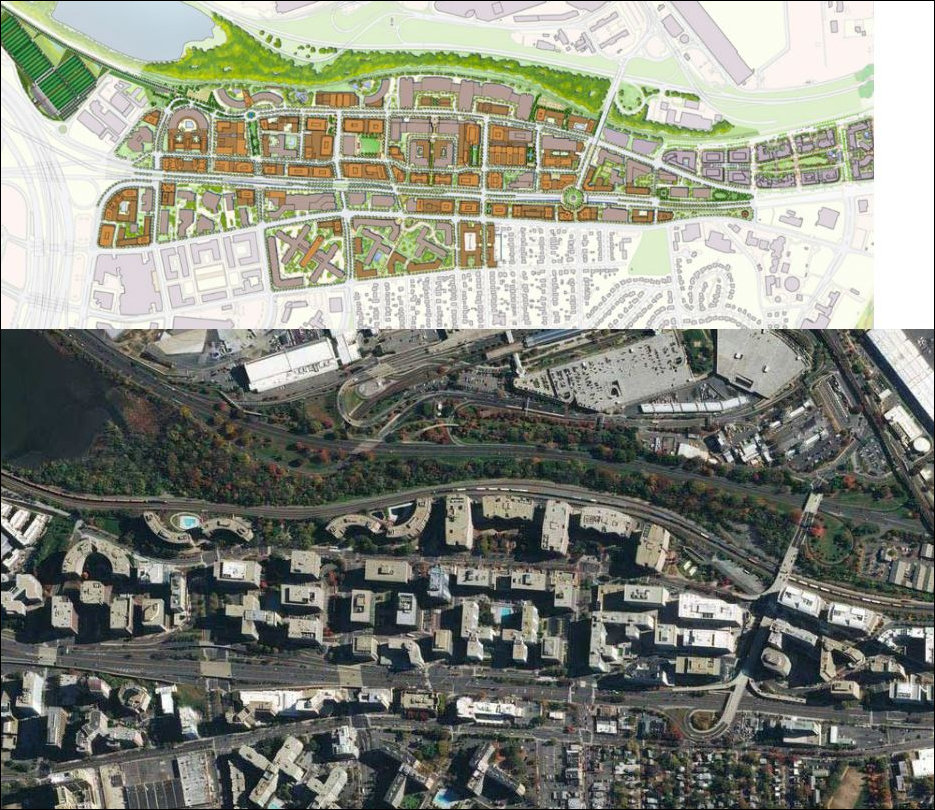
Conceptual rendering of Virginia Tech’s proposed $1 billion campus in Alexandria near the proposed Amazon campus.
More information is coming out about the wheeling and dealing behind Virginia’s incentive package that coaxed Amazon, Inc., to locate a $2.5 billion campus in Northern Virginia. It turns out that many of the key pieces in Virginia’s incentive package were initiatives that had been in the works for years. Virginia is putting resources into projects that, most likely, it would have funded eventually anyway.
Amazon wanted an urban location and it selected the Crystal City-Potomac Yard area of Arlington and Alexandria, currently being rebranded by the largest property owner, JBG Smith, as National Landing. A decade ago JBG Smith had commenced the yeoman’s work, with no immediate prospect of reward, of winning the local planning and regulatory approvals to re-develop the aging edge city into a walkable, high-density, mixed-use area — just the kind of urbanism Amazon was looking for.
Meanwhile, Virginia Tech had engaged in preliminary planning to build a major academic campus in Northern Virginia. The idea was mainly conceptual when Amazon announced his national HQ2 competition, but Tech had a scaffold upon which to build when the state began scrambling to put a deal together.
It helped that Commonwealth’s point man for selling Amazon, Stephen Moret, was not a conventional economic developer. The Virginia Economic Development Partnership president takes a broad, integrative approach to the profession that transcends the assembly of real estate deals. Having recently earned a Ph.D. from the University of Pennsylvania in higher education management and serving as a member of the State Council of Higher Education for Virginia, Moret is well versed in the critical need to build the talent pipeline. He is also conversant about the connections between land use, workforce, innovation districts and economic development.
I haven’t talked to Moret since the Amazon deal was closed. But I recall a conversation a year-and-a-half ago in which he casually blue-skyed an idea for promoting corporate investment in Southwest Virginia by creating a New Urbanism-style development zone around the campus of the University of Virginia-Wise. In that vision, the real estate was almost incidental. Moret’s idea was to create a knowledge-based community with access to UVa-Wise students and graduates that a corporate investor would find attractive.
It’s not a stretch to say that the Amazon project is the same idea writ large — very large. The $550 million in direct employment subsidies constitutes only a modest piece of the deal. What really sold Amazon on Northern Virginia was the prospect of setting its corporate facility (a) in a walkable urban community, (b) in close proximity to a technology-oriented university campus, (c) in order to create a dynamic innovation ecosystem with Amazon at the center, (d) in a metro area with one of the largest tech-savvy labor pools in the country.
Building the talent pipeline. Both the Roanoke Times and the Washington Post have published articles highlighting how the educational piece of the incentives package came together.
As the Roanoke Times writes, Virginia Tech’s proposal to build a $1 billion, one-million-square-foot campus near the Amazon facility was the cornerstone of the talent-recruitment piece of Virginia’s bid.
Virginia Tech had been planning some sort of campus near the nation’s capital since President Tim Sands arrived at the university four years ago. Tech didn’t have a location in mind or much more than a general sense of what the Innovation Campus could be.
“If the first time we had thought about it had been 14 months ago, this probably wouldn’t be what it is,” Sands said during the gauntlet of interviews after Tuesday’s announcement. “We were ready and the timing was perfect.”
Moret was unaware of Sands’ Northern Virginia ambitions when he first reached out to schedule a conference call with college and university leaders around the state last year.
He discussed the HQ2 bid with everyone and laid out early plans to roughly double the number of computer science graduates the state produced each year as part of the HQ2 bid.
He also asked if anyone was interested in the possibility of opening a campus near Amazon in the Washington, D.C., area.
“Virginia Tech reached out right away and said, ‘Hey, we’ve actually been working on this idea for a few years. And we’re prepared to put in a very large investment to make this happen,’” Moret recalled.
George Mason University also stepped up in a big way with plans to expand its Arlington campus. But the GMU campus will not be tightly integrated geographically with Amazon’s like Tech’s will be.
Investing in walkable urbanism. Writing for the Congress for the New Urbanism’s Public Square Journal, Robert Steuteville provides background on the urban planning piece of the deal.
Crystal City can be thought of as a large suburban retrofit—guided by a plan and form-based code that won a 2009 CNU Charter Award for Torti Gallas + Partners and Kimley-Horn and Associates. That plan and code, adopted by the county in 2010, entitled the new, higher-density development and put in place a framework to create a more walkable urban neighborhood over time. …
The area was originally built without a master plan, and that changed with the recent master plan. “It’s high-rise suburban. It wants to be higher density, with a more urban mentality— away from cars and with retail on the street that is accessible to people,” says John Torti of Torti Gallas. “It has the potential of becoming a wonderful place.”
Steuteville’s article provides the following graphic comparing a mile-long segment of Rt. 1 as it looks now with the plan transform it into a more walkable, urban boulevard:
Re-working the urban fabric will require a significant expenditure of public funds for streets, streetscapes and mass transit. The state has committed $195 million for entrances to the Metro stations at Crystal City and Potomac Yard, improvements to Route 1, a connector bridge from Crystal City to Washington National Airport, and a transitway expansion supporting Pentagon City, Crystal City, and Potomac Yard. Arlington County and Alexandria will fund another $570 million for transportation projects, including including rail connections, transit facilities, multi-modal streets, and corridor connectivity serving the site.
It is important to note that redeveloping the Crystal City-Potomac Yard area in line with thew new vision will require a large public investment in infrastructure. While other Northern Virginia jurisdictions might justifiably gripe that Arlington-Alexandria priorities have jumped to the head of the line thanks to the Amazon deal, those priorities likely would have been funded eventually.
About those employment subsidies… As the carefully integrated grand strategy of the Amazon deal is coming into clearer focus, the only questionable aspect to my mind is the $550 million employment incentive. Let me recycle a quote by Secretary of Finance Aubrey Layne that I included in a previous post: “Incentives didn’t really drive the decision. At the end of the day, it was the workforce development and education pieces, which we already had decided were going to happen regardless.”
Amazon’s site-location decision was driven by workforce considerations. The project was so huge and the potential impact on already-tight labor markets — Virginia famously has more than 50,000 unfilled IT jobs — that the e-commerce giant concluded that no single metropolitan region could handle it, not even the largest labor market in the country, New York, or the 7th largest, Washington.
That’s why Amazon broke the project into two parts. Critical to Amazon’s Northern Virginia pick is Virginia’s promise to boost the output of its higher-ed talent talent pipeline.
The requirement for walkable urbanism is tied directly to workforce recruitment and retention. Young people graduating from college have a powerful preference for urban living. To recruit and retain young engineers, data scientists, and IT computer programmers, Amazon must locate in an urban environment to their liking. With only modest transportation funding from the state, Arlington, Alexandria and JBG Smith will fulfill that requirement.
Outside of New York City, could any competing metro match the labor pool, talent pipeline, and walkable urbanism that Northern Virginia provides? I don’t know, but I suspect not. Still, given all the money that other regions were throwing at Amazon, I suppose Virginia’s decision makers felt they had to pad their offer to make sure they won the biggest economic-development deal in U.S. history. Was the $550 million giveaway really necessary? Only Amazon knows for sure.




